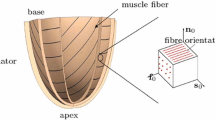Abstract
Assuming a spherical geometry for the left ventricle, passive elastic stiffness-stress relations have been obtained on the basis of linear elasticity theory and large deformation theory. Employing pressure-volume aata taken from rat hearts of various age groups, it is shown that young rat heart muscle (1 month) is stiffer than either adult (7 months) or old rat heart muscle (17 months). Although the qualitative results are similar for both elasticity theories, the large deformation theory gave results in closer agreement with those obtained from papillary muscle studies. These results imply that stiffness of muscleper se can be assessed from left ventricular pressure-volume data.
Similar content being viewed by others
Literature
Barry, W. H., J. Z. Brooker, E. L. Alderman and D. C. Harrison. 1974. “Changes in diastolic stiffness and tone of the left ventricle during angina pectoris.”Circulation,49, 255–263.
Blatz, P. J., B. M. Chu and H. Wayland. 1969. “On the mechanical behaviour of elastic animal tissue.”Trans. Soc. Rheology,13, 83–102.
Bristow, J. D., B. E. Van Zee, and M. P. Judkins. 1970. “Systolic and diastolic abnormalities of the left ventricle in coronary artery disease: Studies in patients with little or no enlargement of ventricular volume.”Circulation,42, 219–228.
Diamond, G., J. S. Forrester, J. Hargis, W. W. Parmley, R. Danzig and H. J. C. Swan. 1971. “Diastolic pressure-volume relationship of the canine left ventricle.Circ. Res.,29, 267–275.
— and —. 1992. “Effect of coronary artery disease and acute myocardial infarction on left ventricular compliance in man.”Circulation,45, 11–19.
Dodge, H. T., R. D. Hay and H. Sandler. 1962. “Pressure-volume characteristic of the diastolic left ventricle of man with heart disease.”Am. Heart J.,64, 503–513.
Forrester, J. S., G. Diamond, T. J. McHugh and H. J. C. Swan. 1971. “Filling pressures in the right and left sides of the heart in acute myocardial infarction.”N. Engl. J. Med.,285, 190–193.
Forrester, J. S., G. Diamond, W. W. Parmley and H. J. C. Swan. 1972. “Early increase in left ventricular compliance after myocardial infarction.”J. Clin. Invest.,51, 598–603.
Gaasch, W. H., W. E. Battle, A. A. Oboler, J. S. Banas and H. J. Levine. 1972. “Left ventricular stress and compliance in man: With special reference to normalized ventricular function curves.”Circulation,45, 746–762.
Green, A. E. and J. E. Adkins. 1960. “Large elastic deformations and nonlinear continuum mechanics.” Chap. 2. Oxford: University Press.
Grimm, A. F., K. V. Katele, R. Kubota and W. V. Whitehorn. 1970. “Relation of sarcomere length and muscle length in resting myocardium.”Am. J. Physiol.,218, 1412–1420.
Hood, W. B., Jr., J. A. Bianco, R. Kumar and R. B. Whiting. 1970. “Experimental myocardial infarction: IV. Reduction of left ventricular compliance in the healing phase.”J. Clin. Invest.,49, 1316–1323.
Janz, R.F., B. R. Kubert, I. Mirsky, B. Korecky and G. C. Taichman. 1974. “The effect of age on passive elastic stiffness of rat heart muscle.”Biophys. J. (April 1976).
Korecky, B., P. Bernath, M. Rosengarten and G. C. Taichman. 1974. “Effect of age on the passive stress-strain relationship of the rat heart.”Fedn. Proc.,33, 321.
McCullagh, W. H., J. W. Covell and J. Ross, Jr. 1972. “Left ventricular dilatation and diastolic compliance changes during chronic volume overloading.”Circulation,45, 943–951.
Mirsky, I. and W. W. Parmley. 1973a. “Assessment of passive elastic stiffness for isolated heart muscle and the intact heat.”Circ. Res.,33, 233–243.
Mirsky, I. 1973b. “Ventricular and arterial wall stresses based, on large deformation analyses.”Biophys. J.,13, 1141–1159.
—, P. F. Cohn, J. A. Levine, R. Gorlin, M. V. Herman, T. H. Kreulen and E. H. Sonnenblick. 1974. “Assessment of left ventricular stiffness in primary myocardial disease and coronary artery disease.”Circulation,50, 128–136.
Timoshenko, S. and J. N. Goodier. 1951. Theory of elasticity. New York: McGraw Hill.
Author information
Authors and Affiliations
Rights and permissions
About this article
Cite this article
Mirsky, I., Janz, R.F., Kubert, B.R. et al. Passive elastic wall stiffness of the left ventricle: A comparison between linear theory and large deformation theory. Bltn Mathcal Biology 38, 239–251 (1976). https://doi.org/10.1007/BF02459557
Received:
Revised:
Issue Date:
DOI: https://doi.org/10.1007/BF02459557




